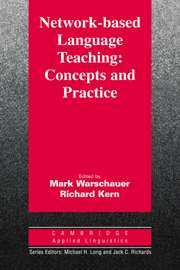Book contents
- Frontmatter
- Contents
- List of contributors
- Series editors' preface
- Preface
- 1 Introduction: Theory and practice of network-based language teaching
- 2 Sociocollaborative language learning in Bulgaria
- 3 On-line learning in second language classrooms: An ethnographic study
- 4 Negotiation in cyberspace: The role of chatting in the development of grammatical competence
- 5 Writing into change: Style shifting in asynchronous electronic discourse
- 6 Computers and collaborative writing in the foreign language curriculum
- 7 Networked multimedia environments for second language acquisition
- 8 An electronic literacy approach to network-based language teaching
- 9 Task-based language learning via audiovisual networks: The LEVERAGE project
- 10 Is networked-based learning CALL?
- Name index
- Subject index
7 - Networked multimedia environments for second language acquisition
Published online by Cambridge University Press: 05 October 2012
- Frontmatter
- Contents
- List of contributors
- Series editors' preface
- Preface
- 1 Introduction: Theory and practice of network-based language teaching
- 2 Sociocollaborative language learning in Bulgaria
- 3 On-line learning in second language classrooms: An ethnographic study
- 4 Negotiation in cyberspace: The role of chatting in the development of grammatical competence
- 5 Writing into change: Style shifting in asynchronous electronic discourse
- 6 Computers and collaborative writing in the foreign language curriculum
- 7 Networked multimedia environments for second language acquisition
- 8 An electronic literacy approach to network-based language teaching
- 9 Task-based language learning via audiovisual networks: The LEVERAGE project
- 10 Is networked-based learning CALL?
- Name index
- Subject index
Summary
Introduction
Networked environments have been used for many years as both a delivery medium and a collaboration tool in second language acquisition. Typical examples preceding the studies reported on in this volume include the use of e-mail for asynchronous collaboration (e.g., Esling, 1991; Barson, Frommer, and Schwartz, 1993; Cononelos & Oliva, 1993; Oliva & Pollastrini, 1995; Warschauer, 1995; Brammerts, 1996; Kern, 1996), support for “writing as process,” including peer-review software (e.g., Michaels, 1993), and on-line discussions for synchronous collaboration between students and for negotiating meaning and developing discourse competence and sociocultural competence (e.g., Beauvois, 1992; Kelm, 1992, 1996; Kern, 1995; Pinto, 1996; Sanchez, 1996; Warschauer, 1996a, 1997; Chávez, 1997). All of the aforementioned work, however, is based on a primarily verbal presentation of information and text-based communication.
In recent years, use of the World Wide Web for delivery of language learning materials has been expanding rapidly (e.g., Godwin-Jones, 1996; Peterson, 1997; Blyth, 1998). There is a plethora of Web sites for language teaching and learning that incorporate the multimedia capabilities of the Web and present information in the form of visuals and audio in addition to text. However, the vast majority of learner production activities involve only text-based responses from the learner (e.g., answering multiple-choice questions about content or grammar, typing in answers to content questions or grammatical exercises, filling in tables with information discovered in the various Web sites, and writing short answers or essays [Moehle-Vieregge, Bird, & Manteghi, 1996]).
- Type
- Chapter
- Information
- Network-Based Language Teaching: Concepts and PracticeConcepts and Practice, pp. 151 - 170Publisher: Cambridge University PressPrint publication year: 2000
- 27
- Cited by

